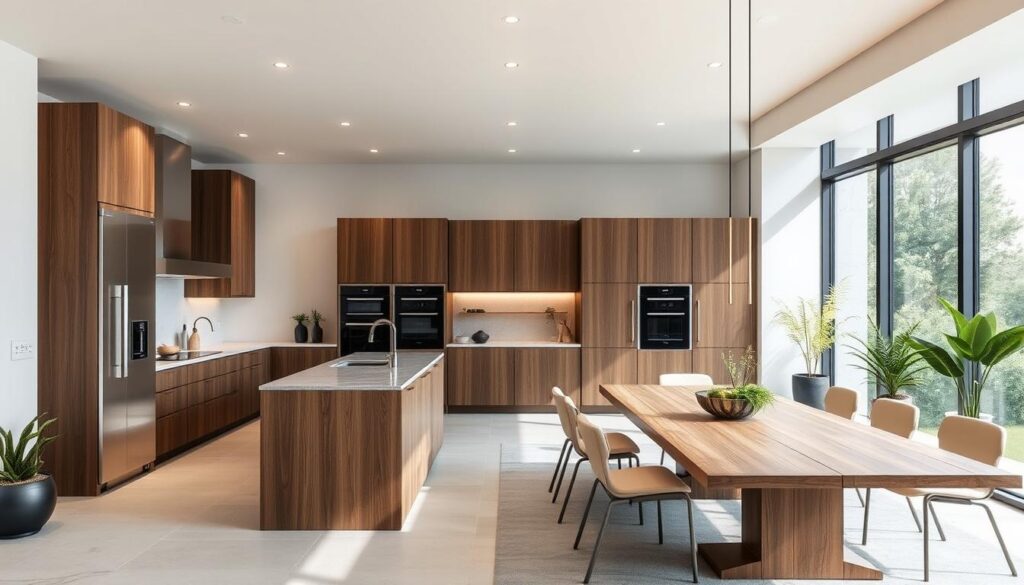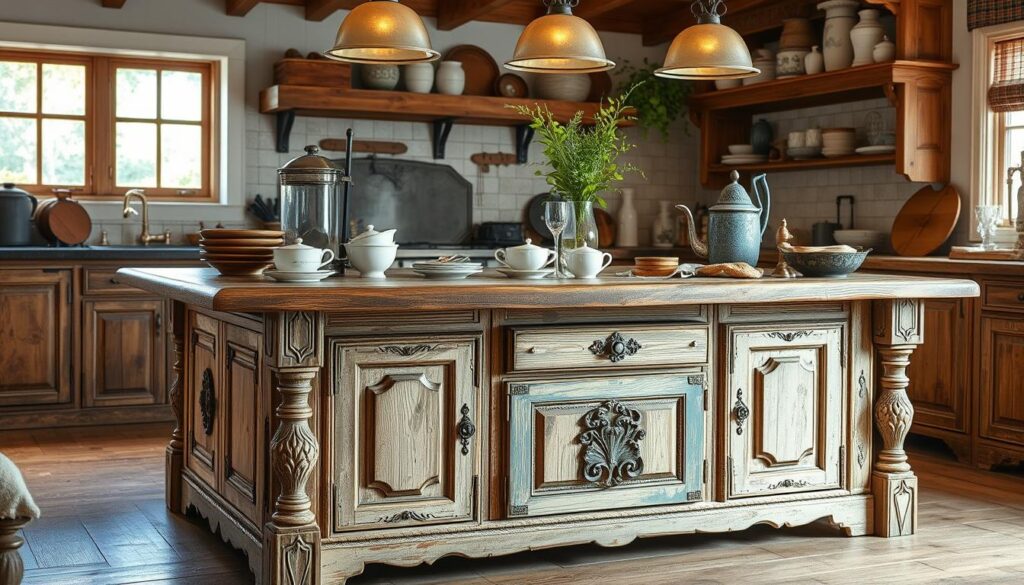Discover space-saving alternatives to kitchen islands that maximize functionality and style in your home. Explore innovative options for your kitchen layout!
Key Takeaways
- Galley or U-shaped layouts can be good alternatives to large kitchen islands in smaller spaces.
- Freestanding tables can provide both social space and additional workspace in the kitchen.
- Kitchen peninsulas offer three sides of workspace and additional storage as an island alternative.
- Prioritizing a good kitchen layout can help maximize space utilization in kitchens without islands.
- Banquette seating can be a stylish and space-saving alternative to a traditional island.
Go for a Galley or U-Shaped Layout
When it comes to kitchen design, the galley or U-shaped layout can be a fantastic alternative to a traditional kitchen island, especially in smaller spaces. By focusing on the “golden triangle” of the kitchen – the strategic positioning of the refrigerator, stove, and sink – designers can create an efficient and ergonomic layout that maximizes the use of available space.
Interior designer Meghan Eisenberg of Studio M.E. notes that a well-planned galley or U-shaped kitchen can be the preferred choice for passionate home chefs who appreciate the ease of movement between the essential kitchen elements. Additionally, embracing the beauty of a small galley kitchen can result in a simple, easy-to-navigate space that feels cohesive and visually appealing.
Consider the “Golden Triangle” of Kitchen Design
The “golden triangle” is a fundamental principle in kitchen design that focuses on the strategic placement of the three core work zones: the refrigerator, stove, and sink. By arranging these elements in an efficient triangle formation, home cooks can minimize the distance traveled during food preparation, cooking, and cleanup tasks. This thoughtful layout can enhance the overall functionality and workflow of a galley kitchen layout or a U-shaped kitchen.
Embrace the Beauty of a Small Galley Kitchen
While some may initially perceive a small galley kitchen as a challenge, embracing the inherent beauty and efficiency of this design can result in a visually stunning and highly functional space. By carefully curating the placement of appliances, storage, and work surfaces, designers can create a cohesive and visually appealing galley kitchen layout that maximizes the available square footage.
Opt for a Freestanding Table
If your kitchen doesn’t lend itself to a traditional island layout, consider using a freestanding table instead. A dining or work table can serve as both a social space and additional workspace, especially if it has built-in storage or drawers. As design director Merlin Wright of Plain English explains, a table or worktable can provide the visual lightness of a piece of furniture while still offering the extra height and storage of a kitchen island. This flexible solution can adapt to the unique needs of your kitchen space.
When it comes to selecting a freestanding kitchen table, there are several options to consider. Multi-purpose kitchen tables can act as both a dining surface and a functional work area, seamlessly blending form and function. Alternatively, a dining table as a kitchen island can create a cozy, inviting atmosphere while maximizing your available space.
| Product | Price | Description |
|---|---|---|
| Next125 Freestanding Kitchen Ideas | Price on application | Available from InHouse Inspired Room Design |
| Base Cabinet Nº 2 from Huckleberry | £3520 | Without a worktop |
| Olive & Barr Handmade Shaker Kitchens | Starting from £10,000 | |
| The Real Shaker Kitchen by Devol | Starting from £18,000 |
By opting for a freestanding kitchen table, you can create a warm, inviting atmosphere in your kitchen while still enjoying the benefits of additional workspace and storage. This versatile solution can be tailored to your specific needs and design preferences, making it a practical and visually appealing alternative to a traditional kitchen island.
What is an alternative to a kitchen island?
While a kitchen island can be a valuable addition to any cooking space, it’s not the only option for those seeking extra workspace, storage, and seating. One compelling alternative is a kitchen peninsula. A peninsula design is essentially an L-shaped extension of your counter that’s attached to the wall on one side, creating a three-sided work area.
According to creative director Elizabeth Sherwin of Naked Kitchens, a kitchen peninsula is an excellent choice for narrower floor plans. “A peninsula can act as a room divider between the kitchen and living areas while still providing additional work surfaces, storage, and seating,” she explains. This layout allows you to enjoy many of the same benefits of a kitchen island without the need for significant square footage.
Compared to a traditional kitchen island, a peninsula design can be a more budget-friendly option, with installation costs typically ranging from $3,000 to $5,000. Additionally, a peninsula can create a visually lighter look in the kitchen, especially in smaller spaces, by avoiding a bulky central island.
For homeowners looking to enhance their kitchen’s functionality and aesthetics without the commitment of a permanent kitchen island, a peninsula is an appealing alternative worth considering.
Prioritize a Good Kitchen Layout
When working with a limited kitchen layout design, prioritizing a well-designed layout is key. By considering alternative shapes and configurations, such as an L-shaped kitchen, homeowners can maximize the use of their available square footage without sacrificing efficient kitchen design. In a small kitchen layout, a layout that keeps the flow open and natural, with easy access to all necessary elements, can be more beneficial than simply inserting a large kitchen island.
One popular option for small kitchens is the L-shaped layout. This versatile design is suitable for compact spaces and can even incorporate a dining area on an unused wall, creating a cozy and functional space. Alternatively, the U-shaped kitchen features three walls of cabinetry, making it suitable for small, medium, and large rooms while maintaining an effective work triangle.
For homeowners with very narrow spaces, a single-wall layout can be an alternative solution, though it requires careful consideration of work zones and counter space. The classic galley kitchen, with its two parallel rows of units, is another option for small or narrow kitchens. Incorporating light colors and an open plan with a central island can help create a sense of spaciousness in a galley kitchen.
“Designing a kitchen layout that enhances functionality and reflects the family’s habits can increase the value of the space and improve daily living.”
Ultimately, the key to a successful kitchen layout is understanding the homeowner’s needs and habits. By prioritizing functionality and tailoring the design to the family’s specific requirements, the kitchen can become a hub of efficiency and comfort, adding value to the home. Working with an experienced design-build firm can help introduce innovative materials and solutions to create a truly customized kitchen design.

Set Up a Banquette
Banquette seating can be a smart alternative to a kitchen island, particularly in smaller spaces. Built-in kitchen banquette seating, which can add a stylish touch of color and pattern, helps save floor space while providing a cozy kitchen nook for dining. The integrated benches can also offer additional built-in kitchen seating and storage underneath, maximizing the functionality of the kitchen. Designers often recommend banquette seating as a way to create a multifunctional and visually appealing space in kitchens with limited square footage.
Utilize Banquette Seating for Space Savings
Many people no longer use formal dining rooms, or have small homes without a separate dining space, making kitchen banquette seating a desirable alternative. By incorporating a kitchen nook with banquette-style seating, you can establish a more true eat-in, group dining experience, catering to multi-generational households with seating at a comfortable height.
Incorporate Built-In Storage Under Benches
The built-in benches of a kitchen banquette can offer valuable built-in kitchen seating and storage space underneath, maximizing the functionality of the kitchen. Designers often include drawers or cabinets beneath the bench to hold table linens, dining accessories, or other kitchen essentials, creating a neat and organized space.
“Banquette seating can be a smart alternative to a kitchen island, particularly in smaller spaces.”
Choose a Breakfast Bar Over an Island
When it comes to kitchen design, the traditional kitchen island has long been a popular choice. However, an increasingly attractive alternative is the breakfast bar. Breakfast bars can serve as a functional and stylish substitute for a traditional island, offering many of the same benefits in a more compact and versatile package.
Breakfast bars provide additional workspace, storage, and a casual dining area, similar to a kitchen island. Design expert Liz Beal of Goddard Littlefair notes that a breakfast bar can help define the boundary between the kitchen and living areas without disrupting the flow of the space, making it a practical choice for smaller kitchens.
Unlike a traditional island, a breakfast bar can be integrated seamlessly into the cabinetry or freestanding, allowing for greater design flexibility. This can be particularly advantageous in kitchens with limited square footage, where a breakfast bar may be a more space-efficient alternative to a bulky island.
| Feature | Breakfast Bar | Kitchen Island |
|---|---|---|
| Seating Capacity | Typically 3 diners | Typically 4 diners |
| Spatial Requirements | Suitable for smaller kitchens | Requires more space, ideal for larger kitchens |
| Cost | Generally more cost-effective | Can be more expensive, especially if requiring plumbing or electrical work |
| Design Flexibility | Offers more integration with cabinetry | Allows for more contrast and stand-alone design |
When considering a breakfast bar over a traditional kitchen island, it’s important to carefully assess the unique needs and constraints of your kitchen space. By weighing the pros and cons of each option, you can make an informed decision that best suits your lifestyle and design preferences.
Replace a Traditional Island with a Salvaged Piece
Instead of opting for a standard kitchen island, designers often recommend incorporating a salvaged or vintage piece of furniture to add character and personality to the space. These unique, repurposed furnishings can serve as an attractive and functional alternative, providing the desired workspace and storage while preventing the kitchen from feeling too fitted and bulky.
Add Texture and Personality with Vintage Furniture
Design director Merlin Wright of Plain English suggests that a farmhouse table or other freestanding piece can be a great substitute for a traditional kitchen island. These types of vintage kitchen island alternatives can add valuable texture and visual interest as a counterpoint to the kitchen’s fitted cabinetry, infusing the space with a sense of history and character.
When considering repurposed furniture in kitchen designs, it’s important to focus on finding pieces that not only serve a functional purpose but also complement the overall aesthetic of the space. By incorporating salvaged or vintage furnishings, you can create a kitchen that feels warm, inviting, and truly unique.
“A farmhouse table or other freestanding piece can prevent the kitchen from feeling too fitted and bulky, while still providing the desired workspace and storage.”

Repurposing vintage or salvaged pieces as an alternative to a traditional kitchen island can be a cost-effective and visually appealing solution. Just be mindful of the practical considerations, such as ensuring that the piece provides sufficient workspace and storage, and that any new stains or finishes blend seamlessly with the existing décor.
Explore Versatile and Mobile Solutions
For homeowners seeking flexible and space-saving alternatives to a traditional mobile kitchen island, mobile solutions like tables and carts on wheels can be a great option. These pieces of versatile kitchen furniture offer the functionality of additional workspace and storage while remaining easily maneuverable, allowing you to rearrange the kitchen layout as needed.
Opt for Tables and Carts on Wheels
A wheeled dining table or kitchen cart can serve multiple purposes, from food prep to casual dining, making the most of your available square footage. These mobile solutions provide the convenience of a kitchen island without the permanent fixture, perfect for small or open-concept kitchens that require a more adaptable layout.
- Increased flexibility to rearrange the kitchen as needed
- Convenient additional workspace and storage
- Suitable for both food preparation and dining
- Ideal for small or open-concept kitchens
By exploring versatile and mobile solutions, you can enjoy the benefits of a kitchen island without sacrificing valuable floor space or limiting your ability to adapt the room’s design over time. Whether it’s a wheeled kitchen table or a mobile kitchen cart, these flexible furnishings can help you make the most of your kitchen’s layout and functionality.
| Feature | Wheeled Dining Table | Rolling Kitchen Cart |
|---|---|---|
| Mobility | Highly mobile and easy to rearrange | Portable and can be moved around the kitchen |
| Functionality | Serves as both a prep surface and dining area | Provides additional counter space and storage |
| Space Utilization | Suitable for small and open-concept kitchens | Helps maximize limited kitchen space |
| Cost | Relatively affordable compared to built-in islands | Generally more budget-friendly than custom islands |
“A mobile kitchen island or wheeled kitchen table can be a game-changer for small spaces, offering the flexibility to adapt your kitchen layout as needed.”
Conclusion
In conclusion, the kitchen island is not a one-size-fits-all solution, and there are many innovative kitchen island alternatives that can provide the same functionality and aesthetic appeal without sacrificing valuable floor space. From galley or U-shaped layouts to freestanding tables, peninsulas, banquettes, and mobile furniture, homeowners have a wealth of options to create a kitchen design without island that is both stylish and highly functional, regardless of the size of their space.
By prioritizing smart design and maximizing the use of every square inch, you can achieve a beautiful and efficient kitchen without the need for a large, bulky island. This is particularly relevant for small kitchen layout ideas, where the strategic placement of peninsulas, banquettes, and mobile furniture can make all the difference in creating a functional and visually appealing workspace.
Ultimately, the key to a successful kitchen design is finding the right balance between form and function, and being open to exploring a variety of alternatives to the traditional kitchen island. By doing so, you can create a kitchen that not only looks stunning but also works seamlessly with your everyday needs and lifestyle.













